Numbers are scary.
That’s the notion we all developed when we went through math in school. Unless you’re a big nerd. Duh.

Jokes aside, the ability to do math and science is critical for unlocking valuable opportunities and skills. By not trying to sharpen your math, I definitely think you’re wasting your maximum brain potential. Even if you don’t want to work in a field that requires heavy mathematical skills, being able to think mathematically is an amazing arsenal to have.
Barbara Oakley, who began her higher education in Slavic languages and literature, was not a math person at all, but later became a professor of engineering. She wrote a book on how to achieve such a feat in A Mind for Numbers: How to Excel at Math and Science (Even If You Flunked Algebra).
This month I’m revisiting this book. It’s a wonderful read for anyone learning math and science—or any discipline that involves problem-solving. I wish I had finished it back in my freshman year of university, when I ended up with a C+ in Calculus 2. Still, the past is past. I hope this article helps you, and also helps me reinforce these ideas in my own learning.
Her premise is that her method is useful to:
- Upgrade anyone who’s already good at numbers and science.
- Change the mindset of anyone who thinks they’re bad at numbers and science to start learning.
I hope this article is useful for anyone in those two categories. Reading this book feels like having a conversation with a friend in a coffee shop. It has had a significant impact on me. The way the author communicates her ideas and provides actionable advice in each chapter makes it a must-read. If you’re interested in the book after reading this article, you can purchase it using the affiliated link here.
Here are the key takeaways from each chapter. I will provide a summary along with my personal notes and interpretations on how to apply these ideas in practice. At the end, I’ll share a concrete plan for how I intend to use the lessons from this book in my life at the time of writing this summary.
The book opens with a heart-warming epigraph, encouraging us to be open:
Lady Luck favors the one who tries.
Law of Serendipity
Chapter 1: Open the Door
Don’t think that just because you’re not naturally good at math, it means you’re not a math person. In fact, there’s no such thing as a math person or a non-math person. We are all naturally capable of performing complex calculations in everyday activities, such as catching a ball, driving, or dancing to the beat of a song. We constantly engage in these calculations unconsciously; math and science are simply formal ways to describe the natural processes we already use. I like to think of this as similar to learning a language. You can naturally express your thoughts in your mother tongue—the thought and intuition are there—but you can only communicate them in speech using that language. To express your thoughts in a new language, you must learn it first. The point of this chapter is to reassure you to not worry. Don’t limit yourself by believing in the hoax of you’re not a math person or the pseudoscience concept of right and left brain. Think positively and be prepared to embark on an uncomfortable, yet highly rewarding journey. Ask yourself, “Have you ever spent significant time focused on learning math and science?” If you haven’t, then it’s completely normal not to be good at them. The next chapters will provide the tools you need to learn them. You will learn how to learn. Are you excited enough? Let’s proceed!
Chapter 2: Easy Does It
Contrary to popular belief, math and science are actually creative subjects. How? Don’t you just need to memorize formulas and be good at the multiplication table? That is true for 3rd-grade arithmetic, but as you progress higher to use math and science for real-life applications, they start to get trickier and creativity becomes necessary.
This is where we are introduced to two modes of thinking:
- Focused mode, where you focus intently on the problem
- Diffused mode, where you turn your focus away from the problem, letting your brain works in the background
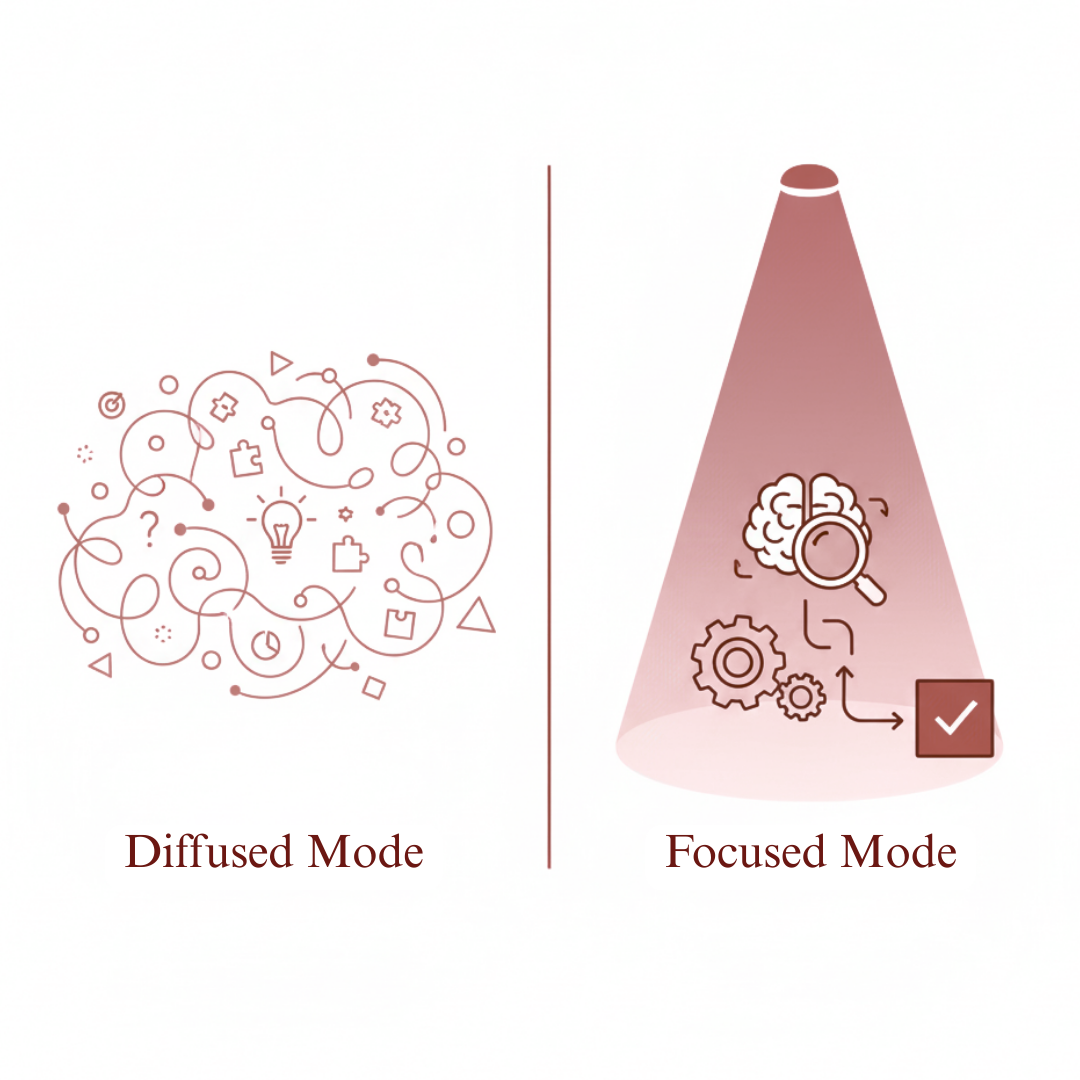
We often get stuck when we encounter a new problem or concept in math or science. The wrong way to approach this is focusing too intently (going into focused mode); instead, try to switch your thinking into diffused mode. Trying too hard to understand a new problem can get you to experience the Einstellung effect, where the initial idea in your mind prevents you from coming up with the correct solution. This is why the ability to switch between these 2 modes is such an important skill in learning how to learn and in math and science, or even problem solving in general. Focused mode is to walk down the path you’re already familiar with, and diffuse mode is zooming out to çreate new paths.
The other way to use this concept is, first, you have to focus on planting the problem into your mind and then use diffuse mode to let the problem slowly ferment and be solved by your subconscious.
The other important thing is not to procrastinate. Procrastinating would only allow you to engage in a shallow problem-solving process because you will have less time to process. Oakley suggests the famous Pomodoro Technique, where you set a timer for 25 minutes, just work, don’t overthink. When the timer runs out, you have a break for 5 minutes and then start over again.
Chapter 3: Learning is Creating
Now, how can we practically switch or shift between the two modes?
Oakley says: “The key is to do something else until your brain is consciously free of any thought of the problem.”
For example, this can be done through sleeping, commuting, showering, or a brief walk. That’s why never procrastinate, start early, and take breaks. Taking breaks does not mean you stop working, because diffuse mode is always working in the background, subconsciously.
Oakley keeps reminding us about the danger of procrastination and rushing. Take your time slowly to build your learning brick by brick, be patient to wait for the mortar to dry, and maximize every time you have.
Progress slowly through mistake by mistakes. The point is to keep going, keep the momentum, don’t give up when you’re getting stuck. Getting stuck means you need to have a break, not to quit.
I remember the Russian psychologist Lev Vygotsky said that imagination depends on how much experience we have. Imagination is important in creativity, and since math and science also need to be done creatively, you have to build up your experience with them to solve increasingly advanced problems. This is where the “learning and creating” loop is formed.
Chapter 4: Chunking and Avoiding Illusions of Competence
Understanding and applying any concept requires a process of “chunking”—collecting multiple small bits of information to form larger conceptual chunks. This chunking is crucial, as it mirrors how we navigate our daily lives. Without this ability to group separate details into higher-level concepts, we would ineffectively use our brain’s processing power.
Take the example of driving a car—on its own, this seemingly simple task actually consists of numerous individual steps and activities, like opening the door, holding the steering wheel, monitoring the road, timing the brakes, and so on. Yet we can cohesively refer to this complex set of actions as simply “driving a car.” The same chunking process applies when learning more technical subjects like math and science—we group foundational principles and procedures into meaningful frameworks that allow us to understand and apply the material effectively.
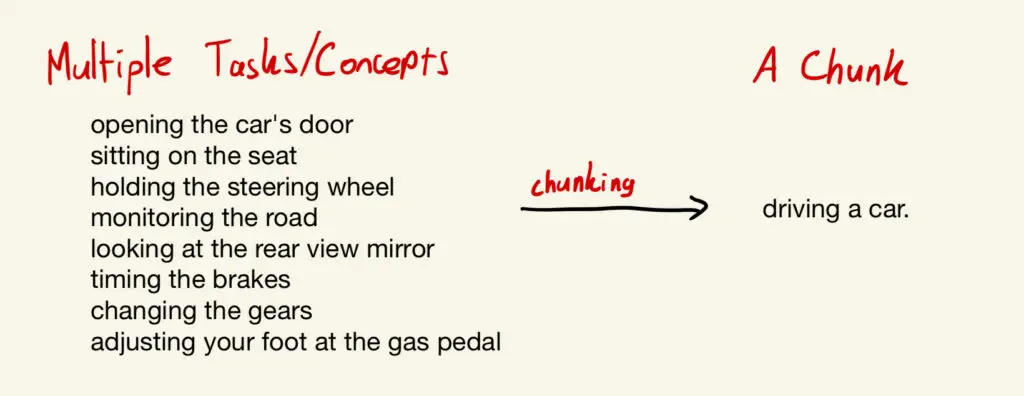
By recognizing the importance of chunking, we can be more strategic and efficient in our learning and problem-solving. Rather than trying to absorb every granular detail, we can focus on identifying the key conceptual blocks and build our understanding from there. Deliberately chunking is an essential skill for making sense of complex ideas and then putting them into productive use. Another way to understand this skill is by seeing it as working through both bottom-up and top-down layers. Top-down means taking a bird’s-eye view to see the big picture, while bottom-up is the process of building those chunks through repetition and practice with the details. This is especially true in fields like math, which are highly compressible; we are, in essence, standing on the shoulders of giants. Building these foundational chunks requires patience, as repetition, while sometimes boring, is worth the trouble. The key is knowing not only how to use both approaches, but also when to switch between them. Relying only on one risks either getting lost in details or overlooking important nuances, so balance is what makes the skill effective.
The steps to execute chunking:
- Focus your attention on the information you want to chunk and remove any distractions
- Understand the basic idea you are trying to chunk
- Gaining context by understanding when to use this chunk
To master this third step, it’s vital to practice interleaving. The author explains, “Interleaving means practice by doing a mixture of different kinds of problems requiring different strategies.” By mixing up your practice, you force your brain to identify the context of a problem before applying a solution. As Oakley notes, “You want your brain to become used to the idea that just knowing how to use a particular problem-solving technique isn’t enough—you also need to know when to use it.”
Another critical component of learning is allowing for mental downtime from, which enables the brain’s diffuse mode from Chapter 2. After a focused session of building chunks, it’s beneficial to take time off. Simple activities like walking, exercising, or even just daydreaming allow your brain to work on the problem unconsciously in the background, helping to solidify your understanding and connect new chunks to your existing knowledge library.
Another important concept of this chapter is combating the illusions of competence.
“I learned very early the difference between knowing the name of something and knowing something.”
–Richard Feynman
It’s common to deceive ourselves into thinking that we already understand something just because we have the book or a laptop in front of us. This is dangerously counterproductive in the long run.
To combat this common pitfall, we must actively recall and engage with the information, rather than simply reading or reviewing it passively. This technique is known as “retrieval practice” – the goal is to store the knowledge firmly in your memory, not just recognize it on the surface level.
As the author notes, “You must have information persisting in your memory if you are to master the material well enough to do well on tests and think creatively with it… The bigger your chunked mental library, the more easily you will be able to solve problems. Also, as you gain more experience in chunking, you will see that the chunks you can create are bigger—the ribbons are longer.”
By consistently testing our recall, rather than passively absorbing information, we can build a robust, flexible grasp of the concepts that will serve us well, both in assessment scenarios and in our broader creative and problem-solving endeavors. It’s a more effortful approach, but the long-term payoffs are immense.
Chapter 5: Preventing Procrastination
Procrastination is one of the most common problems and an important enemy that you have to defeat in order to be good at anything meaningful. Most of us would rather stay trapped in the loop of “I know what I should do, but I don’t want to do it.” Procrastination becomes an addiction, an escape from real work that could actually relieve our stress. Instead, it destroys progress and silently kills dreams. Barbara Oakley frames it as a certain type of poison which is tolerable in small doses, but devastating in the long run. In this chapter, we’ll learn how to recognize it. Procrastination is the enemy, but understanding it also means understanding ourselves—and that is essential to winning the battle.
“If you know the enemy and know yourself, you need not fear the result of a hundred battles.”
–Sun Tzu
Why is procrastination so dangerous? Because it wastes our time and multiplies our stress. Research shows that the stress you feel when procrastinating doesn’t come from the work itself, but from delaying it. Once you finally begin, the stress fades.
Procrastination can also become an excuse for poor performance. You might say, “I had so many things to do, that’s why I crammed all semester’s material last night.” Usually, this isn’t true. In reality, those “busy hours” were filled with scrolling on your phone or idle distractions. The excuse protects your ego, but it also prevents growth.
The first step in breaking free is to notice what makes you uncomfortable. Procrastination arises when you avoid work because you feel stuck and want to escape. Don’t rely on willpower alone. Improvement creates enjoyment, the better you get at something, the more fun it becomes.
Let me give an interesting example.
“I spend hours playing chess because I find it so much fun. The day it stops being fun is the day I give up.”
–Magnus Carlsen
At first glance, that quote might seem strange. Chess? Just a game of moving wooden pieces on a board, a kind of unnecessary mental torture. How could that be fun? I once thought the same way, until about seven years ago, when I decided to give it a try. I picked up some books, practiced, and suddenly I was hooked. That’s when I experienced what Professor Oakley meant: enjoyment comes naturally once you get better at something. The same principle applies everywhere. You can’t enjoy golf if you only see it as hitting a ball with a stick. You can’t enjoy math if you only see it as endless calculations. But if you invest time to learn and improve, enjoyment grows with mastery.
This picture was taken when I was a chess club player at my university. It was during a small tournament in 2023, held in Surabaya, East Java. I no longer have the time to play competitively because of my current workload and research, but I still genuinely consider chess a fun activity. Anyway, let’s move on to the next chapter.
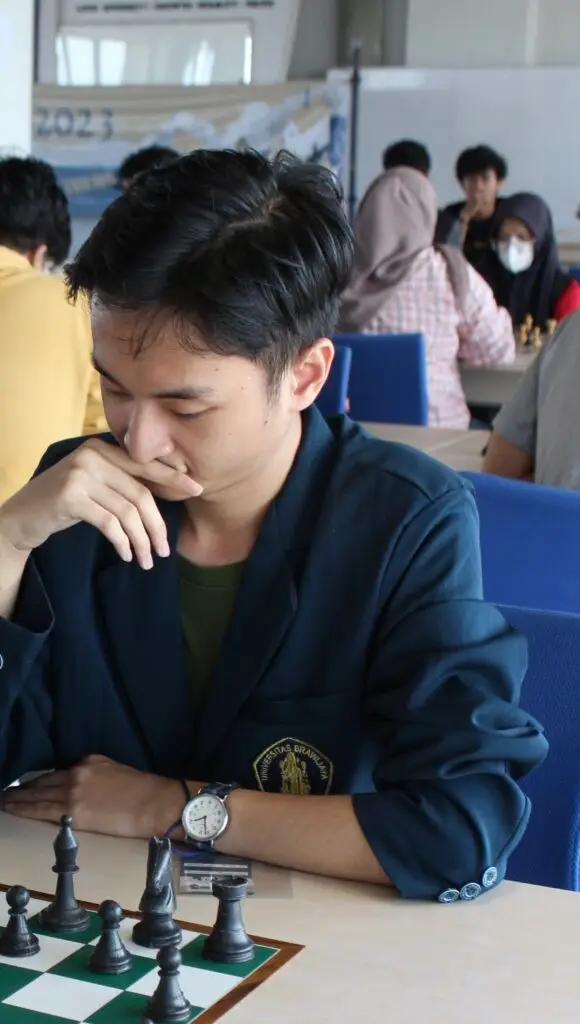
Chapter 6: Zombies Everywhere
Now that we understand what procrastination is—and the excitement and big rewards we might gain if we can overcome it. Let’s dive deeper into how to tackle it. To combat procrastination, we should not rely on willpower. Sheer willpower is not enough and will drain mental energy quickly. Instead, we should form habits that naturally steer us away from procrastination. Why habits? In Barbara Oakley’s words: “Habit is an energy saver.” Habits free up mental bandwidth for other activities. We perform habits all the time because, without them, our brains would burn out from having to consciously decide every tiny detail. Imagine if, every time you brushed your teeth, you had to deliberately think about how each muscle in your fingers should move—it would be exhausting. Our habits are our internal zombies that control most of our actions every day. We should harness these zombies to work in our favor.
That’s why Oakley introduces an important idea from The Power of Habit by Charles Duhigg: the habit loop. It consists of four parts: The Cue, The Routine, The Reward, and The Belief. (Technically, the belief is not part of the original loop in the book, but including it helps us understand how real change happens.)
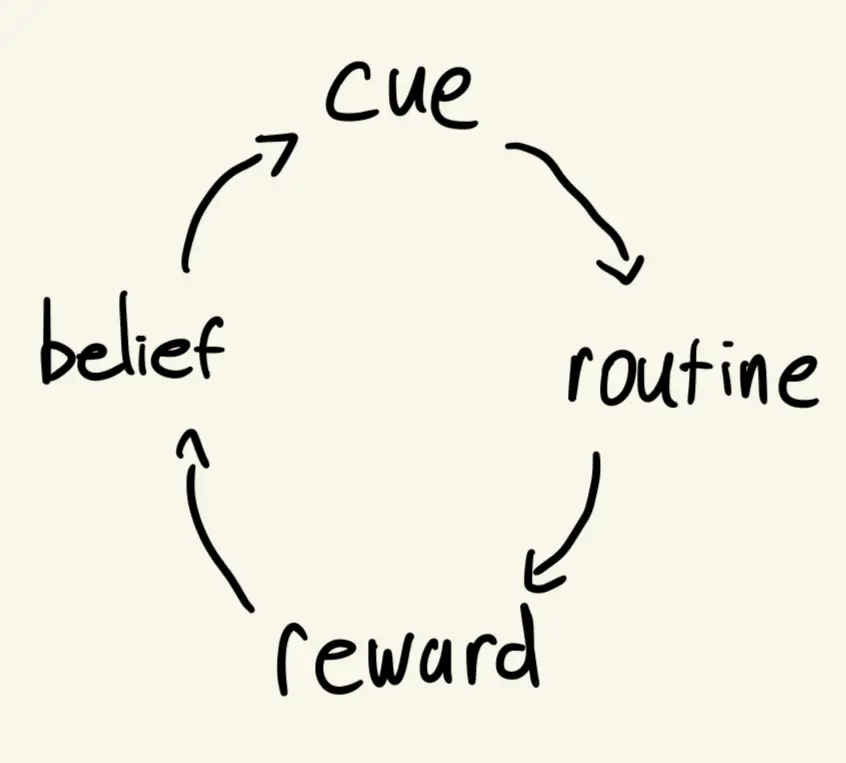
The Cue – This is the trigger that launches you into “zombie mode,” where you act without much thought.
Example: You sit at your desk and open your laptop (cue). Instead of starting your assignment, the sight of the browser tab triggers the urge to check social media.
The Routine – This is the automatic behavior that follows the cue. Routines can be helpful, neutral, or harmful.
Example: The cue (boredom or discomfort) leads to the routine of scrolling through TikTok or YouTube. On the other hand, you could train yourself to replace that routine with opening your notes and writing just one sentence.
The Reward – This explains why habits stick. A reward reinforces the routine, making it more likely to repeat.
Example: With procrastination, the reward is the false sense of relief that comes from distraction: “At least I don’t have to face the assignment right now.” For a positive habit, like exercising, the reward could be the rush of endorphins and the satisfaction of progress.
The Belief – This is the foundation that makes change possible. To truly replace a bad habit with a good one, you must believe that change is possible.
Example: If you don’t believe you can become “a person who starts tasks on time,” your brain will default back to old patterns. But if you shift your identity—even slightly—by saying, “I’m the kind of person who works in small steps,” then new routines can take root.
Focus on the process and not on the end results. I usually procrastinate because of the sense of pride that I’m somewhat a smart guy, I naively think that I’m supposed to be able to do so much things at one time. But that’s a wrong approach. Do one task at a time. That’s the only way you can finish it. Even a multitalented and hypergenius figure like Leonardo Da Vinci could not paint Mona Lisa while scrolling on TikTok or perform an autopsy while drafting a flying machine design.
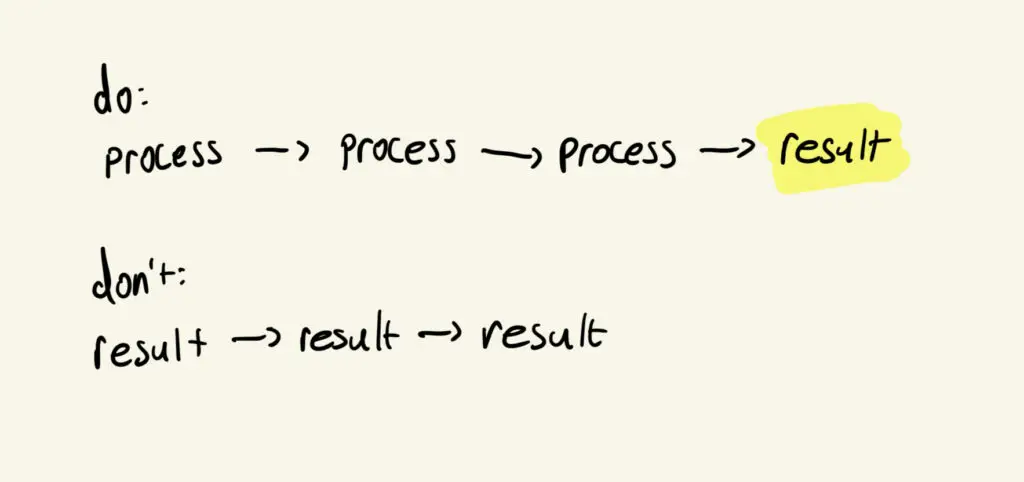
Oakley suggests focusing on the process by using the Pomodoro method. Just start a 25-minute timer, take a 5-minute break, and repeat the cycle. Don’t overthink the product; just know what you need to work on and put in the time without any worries.
The only part where you need willpower is in engaging with the cue. Develop new cues, such as starting to work or study whenever you see something. There’s also a story I read somewhere about people who made a ritual of turning on a desk lamp to start their study session. It sounds dumb, but I actually tried this kind of technique for my #100DaysofPractice challenge with my violin. I love to scroll on my phone, but whenever I came across a violin video, I immediately went to my room and practiced for at least 15 minutes. I reached a 71-day streak before finally missing days. Now I’m doing the same challenge again, currently on day 10. So it does work. Associate your brain with a certain routine and cue, and keep training. This is what harnessing your zombie is.
Chapter 7: Chunking vs Choking
We learn about refining the chunking skill in this chapter. The author explains that the reason she keeps switching back and forth in every chapter is to demonstrate interleaving, which means varying our learning to strengthen an approach we’ve learned earlier.
To refresh, chunking is important because, similar to habits, it simplifies the operation of our mental faculties. You don’t need to think step by step about brushing your teeth, from opening the toothpaste tube, applying it to your toothbrush, and controlling each small muscle in your fingers. You simply brush your teeth.
In this chapter Oakley lays out step-by-step to build a powerful chunk:
1. Work a key problem all the way through on paper.
2. Do another repetition of the problem, paying attention to the key processes.
3. Take a break.
4. Sleep.
5. Do another repetition.
6. Add a new problem.
7. Do active repetitions.
Remember that the more effort you give in recalling the material, the more you’ll be able to memorize it. We’re utilizing what’s called the generation effect. Recall, recall, recall.
We have to organize these chunks neatly in our minds, like a personal chunk library. Imagine your brain as a computer with digital folders. Make an effort to sort those chunks into the right folders. When you need them, you can simply “click” on the right folder. This helps you avoid choking—that moment when you freeze during a test or in real-life situations. That’s why it’s important to simulate test conditions during practice.
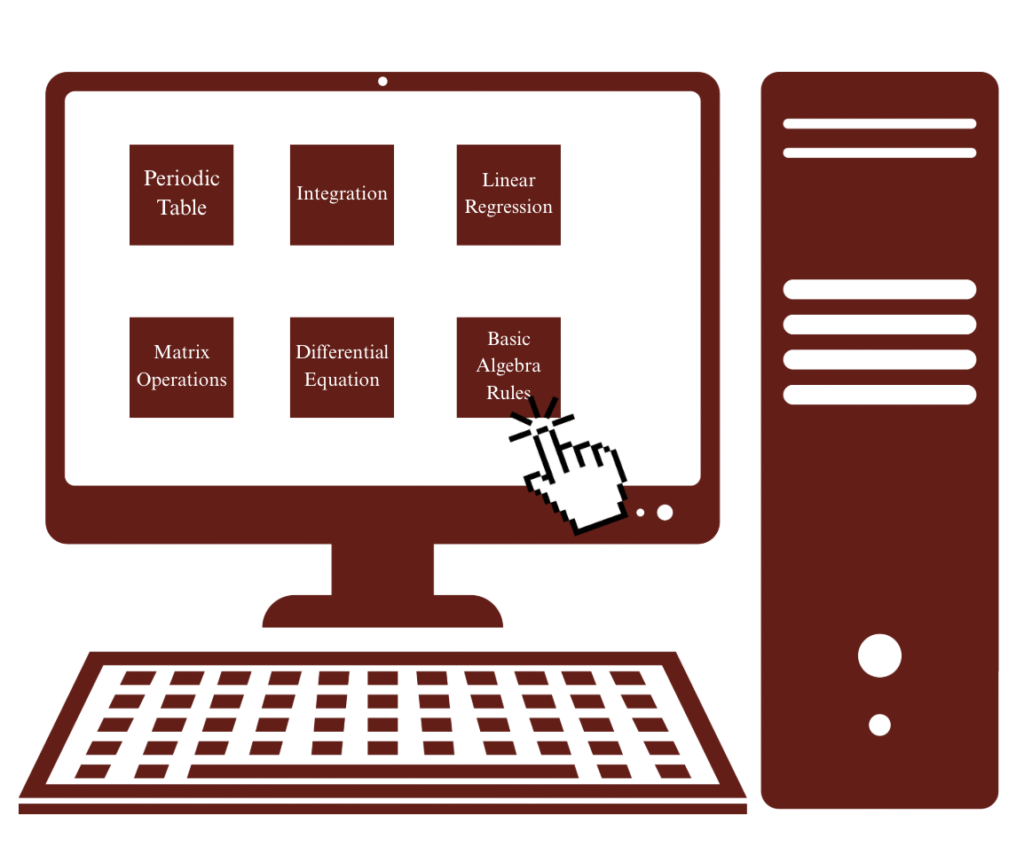
It may sound like a lot of effort, but trust me, it’s worth it if you truly want to succeed.
Chapter 8: Tools, Tips, and Tricks
Now we’re going to learn about tools, tips, and mental tricks we can use to optimize and execute what we’ve learned so far.
A few mental tricks to combat procrastination:
- Let negative thoughts drift away by reframing your focus on positive things. For example, instead of dreading the work of solving math problems, focus on the fact that after this session you’ll be able to do it better, even if it’s only 1% better.
- Work hard, play hard. Schedule dedicated guilt-free playtime where you don’t need to think about work. Maybe an episode of your favorite series after every 5 hours of work, or it can be a day of hiking every weekend. This way, you know you won’t be missing any leisure, and there’s no reason to procrastinate.
- Go into a quiet place (like a library) to start your work.
- If you still struggle, just start. Don’t wait for perfect circumstances, because they won’t arrive.
IMPORTANT: Make a specific to-do list for every day. Don’t overcomplicate it. Write the specific task, the duration needed, and the deadline to finish all the tasks that day. Besides a daily to-do list, make a weekly goal list to see the big picture. Remember not to overthink this.
For tools, you can use a simple watch and a notebook. You can also use a smartphone, but don’t get distracted. I personally use Apple Notes (for task list), Forest (for Pomodoro) and Dumbify Launcher on my phone (not sponsored).

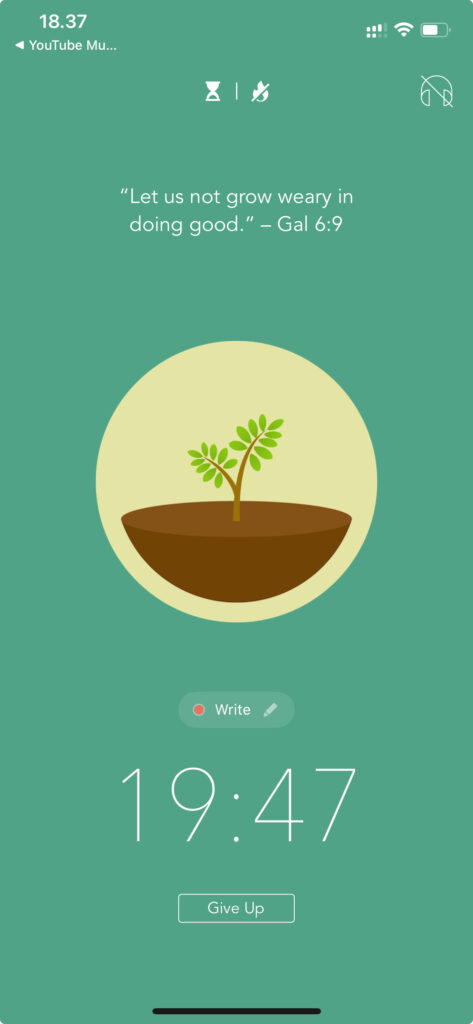
In the end, it’s important to self-experiment. Not everyone is the same. Some don’t have a library nearby, some don’t have enough time for a 25-minute Pomodoro session, and some don’t use the same apps. Observe why you failed, why you started procrastinating, and adjust little by little to see how much change you experience. Do what works best for you based on the underlying framework.
By the way, if you’re interested in the work hard and play hard part, I found this 4 minute video from Thomas Frank:
Chapter 9: Procrastination Zombie Wrap-Up
This chapter gives another insight into combating procrastination. Remember that the reason the author keeps moving back and forth is to demonstrate interleaving technique in learning.
Many of us wait until the deadline is close to start working, “binge working” in a time crunch. This is a bad habit—it relies on stress and adrenaline, produces less overall work, and prevents real growth. Math and science especially need time for neural networks to develop, as we saw in the chunking process.
Here are Oakley’s Procrastination FAQs, summarized:
Q: What if I feel paralyzed by too much work?
A: Break it into three small tasks and focus on one at a time.
Q: How long does it take to change procrastination habits?
A: It depends, but generally around three months, so be patient and consistent.
Q: My attention jumps around—am I doomed?
A: No, use tools like planners, timers, and apps to keep focus.
Q: Shouldn’t I use more willpower to fight procrastination?
A: Willpower is like a muscle—use it wisely and focus on one change at a time. Use willpower only on the cue that sparks your certain habit.
Q: I get distracted by social media when I start working.
A: Use the Pomodoro timer to block out short, focused sessions. You cannot fully change on day one, but just keep working steadily, one Pomodoro session at a time. As simple as that.
Q: What about students who blame others or overestimate their ability?
A: Take responsibility—success comes from steady effort, not excuses.
Extra tip from Oakley: There’s a form of procrastination that can actually be healthy. We saw in the first chapters that constant focus isn’t always good—we also need diffused attention to let what we’ve learned “marinate.” Not every delay is bad; sometimes waiting wisely is the right move.
This is about maturing and cultivating patience. Where should we apply healthy procrastination? Pause and reflect when making important decisions and thinking about where you want to go in life. Don’t just rely on emotions—let the decision-making settle so you can decide with a clear head.
Chapter 10: Enhancing Your Memory
You can train your memory. This chapter begins with an example from Joshua Foer, an American journalist who became the 2006 USA Memory Champion. According to the story, he was just an ordinary guy when it came to memory. He even forgot simple things like his girlfriend’s birthday. But over time, by using the right approaches, he trained himself and eventually won the national competition.

What are these approaches?
First, we need to realize that our memory is already remarkable. We can remember faces, streets, songs, and stories. Even if you struggle with some of those, there are surely things you recall effortlessly—maybe Pokémon attack combinations, obscure recipes, or sports stats. Unless someone suffers from dementia or Alzheimer’s, everyone has a natural base of memory to build upon. The goal is to extend and refine that ability.
Here are some memory tricks used by memory champions:
1. Memory Palace
This is one of the oldest and most powerful techniques. You take a familiar place—your house, your campus, or even a favorite video game map—and mentally “place” images of what you want to remember in specific spots along a route. Later, when you walk through this “palace” in your imagination, each location will cue the item you stored there. For example, if you need to remember a grocery list, picture a giant carton of milk spilled across your front door, bananas hanging from your ceiling lamp, and a loaf of bread sitting on your bed.
2. Memorable Visual Images
Our brains are wired to retain vivid, unusual, or emotional images. If you need to memorize something abstract, turn it into a picture in your mind. For example, if you want to remember the word “table,” imagine a giant table walking down the street on human legs. The more absurd, exaggerated, or emotionally charged the image, the better it will stick. Another example is if you need to remember an equation like E = mc², imagine a giant glowing “E” crushing down on a tiny “m” and “c” racing around in circles squared off like a boxing ring. The more absurd or vivid the picture, the easier it is to recall.
IMPORTANT: Memorize only after you understand. Don’t rely on rote memorization without comprehension. It will give less meaning to what you learn and make you forget it easily.
Chapter 11: More Memory Tips
Following the last important tip, the way we should interpret concepts in math and science is by connecting metaphors to them. Why? Because without meaning, they’re just equations sitting around with random numbers and Greek letters in our heads. Even science at its most basic definition is just us interpreting reality built on metaphors that get closer and closer to the actual thing.
A funny example is to compare a cation to a cat because cation is positive (pawsitive) and an anion to an onion because negative news makes people cry like an onion. As an electronics engineering student myself, my professor taught me to associate electric current with water flowing in a pipe, voltage with water pressure, and a switch with a valve. As I continued studying, I realized these metaphors aren’t exactly accurate to real electrical properties, but they were good enough to get me started in learning circuits.
Metaphors are never perfect, but they help glue concepts into memory. We can always refine or replace them as our understanding deepens.
Another way is to create stories to associate with what you’re learning. For instance, if you’re studying the order of operations (PEMDAS: Parentheses, Exponents, Multiplication, Division, Addition, Subtraction), you might imagine a little story: Parentheses are the parents who go first, Exponents are their powerful kids, Multiplication and Division are twin siblings who always come together, and Addition and Subtraction are the easygoing friends who arrive last. Turning abstract steps into characters in a story makes the order far easier to recall.
You can also use mnemonics. A classic example is in the periodic table: “Hi He Likes Being Cool Not Often Funny Naughty” to remember the first ten elements (H, He, Li, Be, C, N, O, F, Ne). Or for the resistor color code, students often learn: “Black Bears Run On Yellow Grass But Violet Goes Walking” (Black, Brown, Red, Orange, Yellow, Green, Blue, Violet, Gray, White). Mnemonics are silly, but that’s exactly why they work—the humor or strangeness makes them stick.
It’s also important to write when you study instead of only typing on a laptop or smartphone. The physical act of handwriting strengthens memory and helps you process the concept more deeply.
Another important tip is to exercise. Being good at math or science is not only about studying—the body carries the brain. By taking care of your body, you also help your brain learn more effectively. Neuroscientist Wendy Suzuki’s research shows that even simple, consistent exercise can enhance mood, focus, and long-term memory, giving your studying a boost.
Chapter 12: Learning to Appreciate Your Talent
It’s very important not to get paralyzed by impostor syndrome. It’s the feeling that even when you achieve something, you don’t truly deserve it. You feel like a fraud. I personally experienced this when I first won a research writing competition in 2023. The feeling kept coming back until I finally accepted that if I’m not good enough yet, I just need to keep learning and genuinely creating.
But if this feeling isn’t handled properly, it can become dangerous in the long run. Some people choose to ignore their impostor syndrome completely, but doing so often leaves them empty after each achievement, because they never take the chance to confront it and grow from it.
Oakley suggests that whenever we feel impostor syndrome, we should remember that we’re not alone, many people experience it, even at the highest levels. Everyone has different natural gift. The key is to treat it properly: if you know you lack a certain skill, appreciate this fact by working hard to improve it. If you know you have a gift, appreciate it and use it to learn and grow. The point is to appreciate what you have. Never give up.
Chapter 13: Sculpting Your Brain
This chapter opens with another inspiring story that shows change is possible. Oakley tells us about Santiago Ramón y Cajal, the first Spaniard to win the Nobel Prize and considered the father of modern neuroscience. He had a troubled childhood—the kind of kid no one would expect to become “the smart type.” You could have easily labeled him a typical troublemaker if you only looked at his past. This reminds us that different people have different brains, and those brains mature at different ages. But we shouldn’t just wait for this moment of maturity; we should aim to trigger it by constantly learning and trying. Cajal didn’t just sit around waiting for change—he deliberately studied and sought guidance from people smarter than him as he learned.
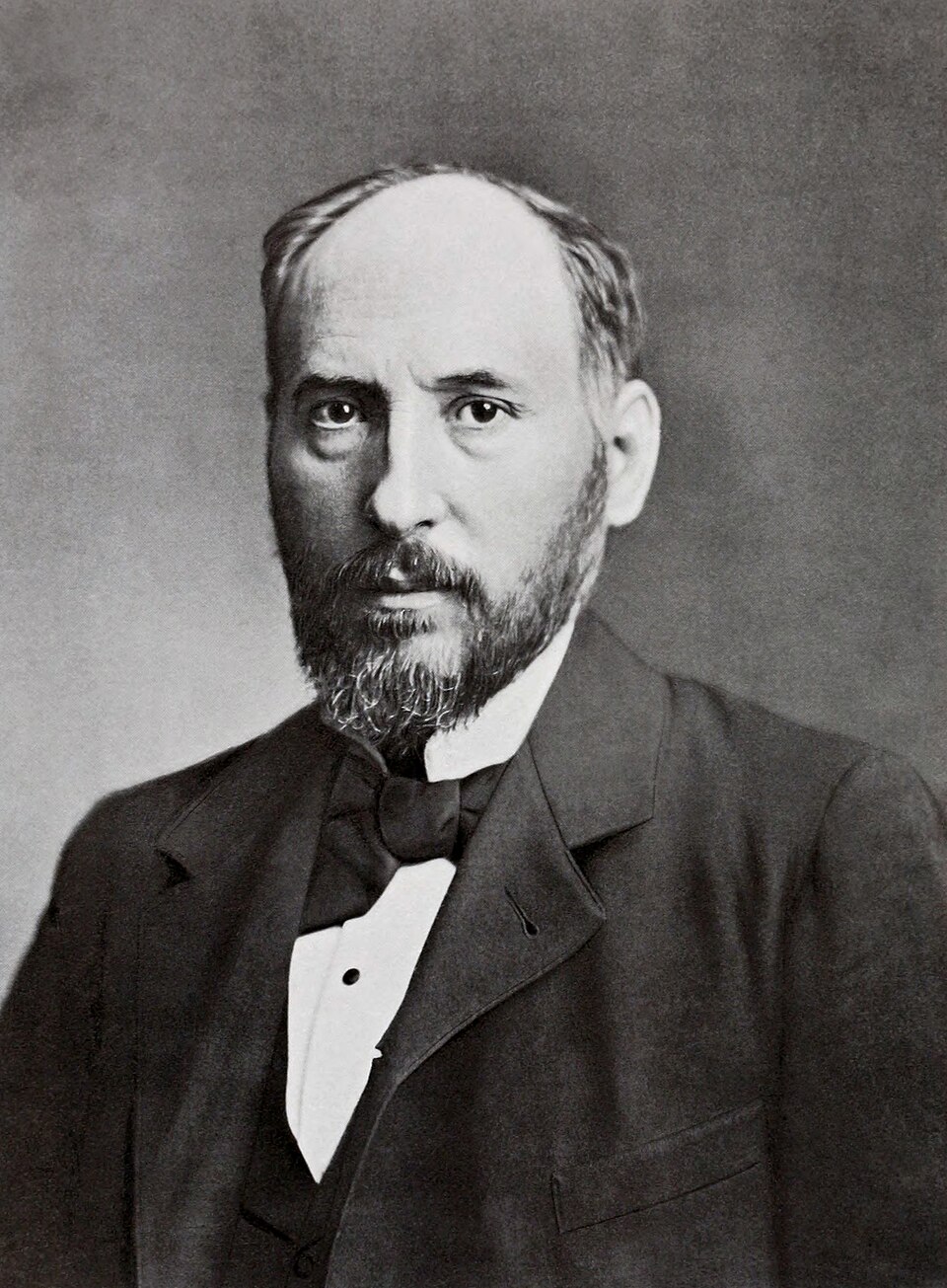
Cajal believed that we can “sculpt” our brains, and that even average people can achieve greatness through effort. Oakley quotes him:
“Deficiencies of innate ability may be compensated for through hard work and concentration. One might say that work substitutes for talent, or better yet that it creates talent.”
The point is that our brains can change by changing our habits and ways of thinking. The more we engage in certain neural patterns, the more natural they become. This is neuroplasticity. We should never underestimate this ability: you grow into what you consistently do. There are no shortcuts—this process itself is the magic we have to go through.
Another key point in this chapter is the chunking process, specifically deep chunking. This goes beyond simply cramming concepts together in your head. Deep chunking is personal. Everyone learns differently. Cajal, for example, studied cells by carefully redrawing them through a microscope. He was also a photographer, but drawing was his way of absorbing and understanding. For him, drawing was how he “chunked.”
Oakley explains:
“Good chunks form neural patterns that resonate, not only within the subjects we’re working in, but with other subject and areas of our lives. The abstraction helps you transfer ideas from one area to another.”
This is why a concept learned in math might help you understand something in another field, and vice versa—you might even grasp math better by associating certain concepts with techniques in fishing. The possibilities are endless because everyone’s way of learning is unique.
That’s also why we should never dismiss art or experiences just because they’ve been repeated many times before. Every movie, book, or artwork resonates differently with each person. Learning works the same way—it’s not just about information, but about how it connects and resonates within you. In this sense, learning itself is a deeply creative process.
Chapter 14: Developing the Mind’s Eye Through Equation Poems
Continuing from the last chapter’s summary: learning is personal. When someone tells you about good food, you have to taste it yourself to fully understand what they mean. The same goes for poetry—if someone says Kahlil Gibran’s poetry is beautiful, that alone is not enough. You have to read it, let the words process within you, and immerse yourself in the rhythm and meaning. Only then can you truly appreciate it. No one can do this for you—you have to read or listen to it yourself.
“A mathematician who is not at the same time something of a poet will never be a full mathematician.”
–Karl Weierstrass
The first chapter reminds us that math is just a language. Like any other language, it captures ideas and turns them into something communicable and writable, built upon its axioms. In this sense, math equations can also be interpreted as a kind of poetry. Just like poems, equations carry deeper meaning that requires effort to understand beyond face value.
Oakley uses the equation for work in physics as an example. Work is simply energy transferred when a force moves something through a distance. Written simply:
w
w = f·d
w = (ma)·d
This “equation poetry” tells a story: work is the product of a push (force) across a space (distance). And force itself comes from mass times acceleration—so whenever we move something, we are linking mass, motion, and distance into energy. The symbols condense a world of meaning into a single line.
This is why imagination is such a crucial skill to cultivate. We must learn to turn chaos into order, abstract concepts into concrete mental images. Oakley gives examples such as Einstein, who imagined himself as a photon interacting with other photons, and Nobel Prize winner Barbara McClintock, who imagined herself as the molecular elements she studied—“making friends” with them so that abstractions became tangible.
Scott Young, the creator of the MIT Challenge (where he attempted to learn the entire four-year MIT computer science curriculum in just 12 months), popularized the Feynman Technique. This involves explaining what you’ve learned in a simplified way, either to a real person or by imagining an audience. It works because you often understand something more deeply only when you try to explain it clearly.
Another important technique in this chapter is transfer, which is the ability to apply what you’ve learned in new contexts. If you’ve learned one programming language, it becomes easier to pick up another because you already understand the underlying logic. The same applies to math: once you’ve internalized mathematical reasoning, you can transfer it into engineering, physics, economics, or even everyday decision-making.
Here it is reminded about the danger of multitasking and shallow learning. If you divide your attention too broadly during the initial chunking process—checking your phone, listening to music with lyrics, or distracting yourself with side activities—you weaken your ability to transfer knowledge. Focus is essential to make learning stick.
Chapter 15: Renaissance Learning
Persistence is often more important than intelligence in learning. Persistence breeds intelligence when you’re still not “intelligent enough.” That’s exactly what happened to people like the scientist from Chapter 13, Santiago Ramón y Cajal.
We’ve also seen the importance of personalization in Chapter 14. Here we explore another layer of it through learning on our own. Why is it necessary to learn independently, not just in the classroom or with tutors and professors? Because only then can we discover what works best for us. Learning on our own means approaching material with the genuine goal of understanding, with the intention of truly grasping something rather than just performing for others.
When you learn independently, you also build resilience and problem-solving skills. Struggling through a difficult concept on your own forces you to experiment, search for patterns, and create connections in ways that passive learning never provides. This process may feel slower, but it strengthens your ability to think critically and adapt. These are skills that become invaluable not only in academics, but in real-life challenges.
We should learn with the the Renaissance spirit, which is learning broadly, deeply, and personally, with persistence and curiosity as the driving forces.
Chapter 16: Avoiding Overconfidence
Focused mode can sometimes cause us to skip over our mistakes—that’s why we also need diffuse mode. But our own diffuse mode is often not enough. This is where teamwork comes in: it serves as an external diffuse mode. Learning on our own is necessary, but teamwork is equally important.
By working with others, we avoid overconfidence and arrogance. Surround yourself with colleagues who support you but are not afraid to disagree. We are social creatures, and everyone has blind spots. Honest criticism exposes those blind spots and gives us the chance to improve. The key is to use criticism as a platform to reassess and grow, rather than taking it personally.
If criticism does sting, the best remedy is practice. The more you work and refine your skills, the less criticism feels like an attack and the more it becomes fuel for growth. In this way, teamwork and feedback transform from challenges into powerful tools that expand our perspective and strengthen our learning. This is totally not teachable by words, you have to engage and truly fight on your own.
Chapter 17: Test Taking
An hour of testing yourself or recalling will help you learn far more than an hour of rereading material mindlessly. This chapter reinforces that point again and again—because IT REALLY IS THAT IMPORTANT.
Every chapter in this book emphasizes recalling and testing, because these two practices solve most of the problems in learning. Even if you can’t remember every detail from the book or even from this summary, at least remember this: always practice recall in your learning. That’s what makes knowledge stick.
Remember that it’s not “practice makes perfect,” but “practice makes permanent.” How you practice is how you’ll perform. If you underestimate the value of practice tests, you’ll likely perform poorly when it matters most. There’s no shortcut here; the same principle applies to any skill worth learning.
To help you prepare better for tests, Oakley offers a few tips:
- Hard-Start-Jump-to-Easy Technique
Begin with the hardest problems first. If you get stuck, don’t waste time—jump to the easier problems to engage your diffuse mode, then return to the hard ones later. - Responding to Stress and Anxiety
Stress during tests is natural; what matters is how you respond. Instead of feeding negative thoughts like “This test is impossible, I’m going to fail”, reframe them into resilience: “This test excites me. I’ll give it my best effort to study and perform.” As Oakley reminds us in Chapter 13, changing your thoughts can change your life. The more you repeat this mental pattern, the more resilient you become.
Cristiano Ronaldo is a well-known example of this mindset. He often performs better under extreme pressure, which seems counterintuitive—but that’s exactly the mentality we need in learning. With practice, pressure becomes fuel rather than fear.

“Your love makes me strong. Your hate makes me unstoppable.”
–Cristiano Ronaldo
- Optimal Final Prep
A day before your test, take a quick look over the materials, review your solutions with fresh eyes, trace back your logical processes, and ask yourself, “Does this make sense?” Watch out for missed minus signs, miswritten numbers, or small details. Every detail counts. And most importantly—get enough sleep before the test. - Never Get Discouraged
Even if you prepare thoroughly, sometimes you’ll still get poor results. But if you don’t prepare at all, failure is almost guaranteed. Keep preparing consistently, and over time you’ll notice that “luck” starts tilting in your favor.
“I am a great believer in luck. The harder I work, the more of it I seem to have.”
–Unknown
Chapter 18: Unlock Your Potential
We’ve reached the concluding chapter. Let’s wrap this up with the main ideas:
- Einstellung effect. Your initial approach can block better solutions. The urge to solve something immediately can prevent you from solving it at all. Combat this by deliberately switching between focused and diffuse modes of thinking.
- What you can control. The difficulty of a skill or subject is outside your control, but reshaping your brain is in your control every day. The key is patient persistence and informed decision-making.
- Focus by beating procrastination. Identify the cues that trigger procrastination—phone notifications, a negative feeling toward a subject, etc. Notice them and actively reject them, and develop counter-cues that help you focus intently. Habit change must happen daily and can take months to solidify, so be patient.
- Don’t fool yourself. Be critical in your own learning. Double-check your logic and solutions. Step back and examine your thinking from different perspectives. Avoid the illusion of competence—practice recall, recall, recall, not mere rote memorization.
- Visualize and personalize. Turn concepts into images and explanations that make sense to you. Even the best simplify to grasp difficult ideas. Simplifying doesn’t mean watering things down; it means helping your brain digest them more effectively through visualization and your personal approach. Experiment to find how you chunk this information best.
Remember, you’re not stupid. Celebrate your wins. If you’ve made it to the end of this, it already shows you have the baseline potential to build on. Change is possible and we’ve seen it again and again. Unlock your potential by keeping at it and making informed decisions. There is no shortcut. I repeat, there is no shortcut. The shortcut and the magic you’re looking for lie in this very process you may be avoiding.
Practical Rules
In the very end of the book, Oakley lays out ten do’s and don’ts for studying math and science. This is the climax and the practical rules you can apply immediately, even without reading the whole book or knowing all the reasoning behind them.
✅ Do’s (Ten Good Studying Rules)
- Recall, don’t just read. After a page, look away and bring back the ideas from memory.
- Test yourself often. Flashcards, quick quizzes—check what you really know.
- Chunk it. Practice problems until the steps click into one smooth flow.
- Space it out. Study a little each day—your brain’s a muscle, don’t overload it.
- Mix it up. Use different problem-solving methods; review errors right after.
- Take breaks. Step away when stuck—let your brain work in the background.
- Explain it simply. Teach it like to a kid; use analogies, say it out loud, or write it down.
- Focus hard. Kill distractions, set a timer, and reward yourself after deep sessions.
- Eat the frog. Do the hardest task first when you’re fresh.
- Picture the goal. Contrast where you started with where you’re going—keep your dream visible.
❌ Don’ts (Ten Bad Studying Rules)
- Don’t just reread. If you can’t recall it, rereading is wasted time.
- Don’t highlight blindly. Highlight only what you’ve already processed in your head.
- Don’t peek at solutions. Solve it fully on your own at first, step by step.
- Don’t cram last minute. Brains need time—like muscles, they don’t bulk overnight.
- Don’t repeat only what’s easy. Practicing the same solved problems is fake progress.
- Don’t turn study groups into hangouts. Work first, chat later.
- Don’t skip the textbook. Skipping context is like diving without knowing how to swim.
- Don’t stay confused. Ask questions—professors and peers exist to help you.
- Don’t multitask. Every distraction rips at your focus. Protect your attention.
- Don’t cut sleep. Sleep cements memory and clears your brain—without it, nothing sticks.
How Do I Apply These Ideas Myself?
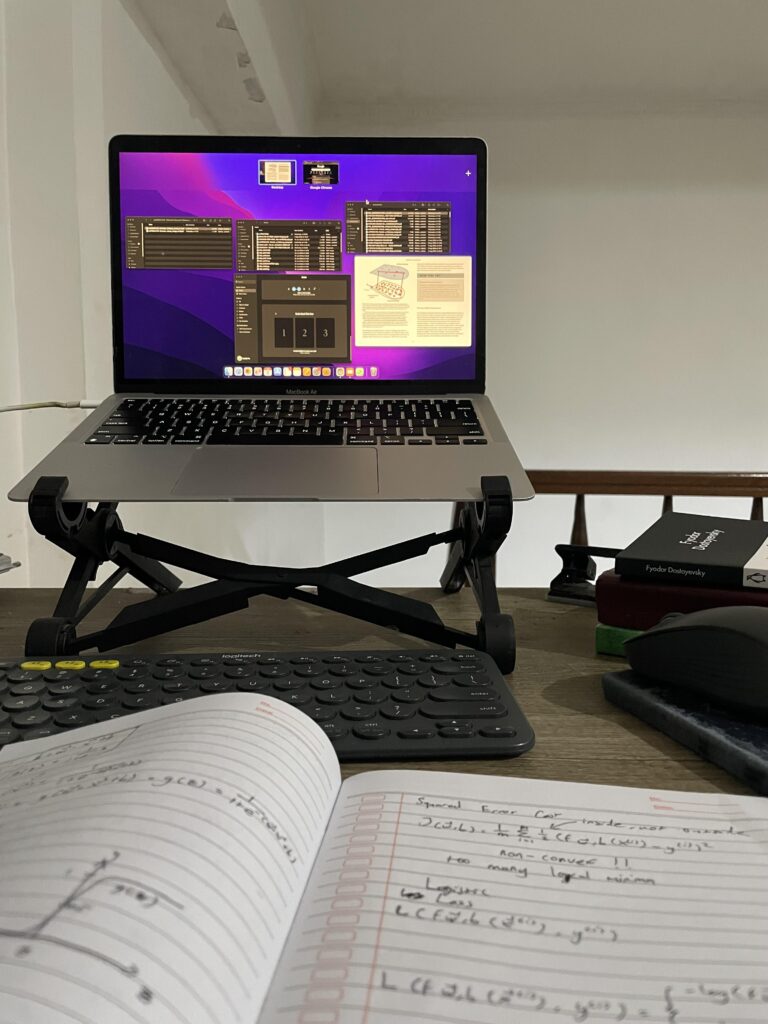
I thought to myself: Well, I failed Calculus 2 in my third semester with a C+. There’s no point in regret. So let’s finally put the ideas from this book into what I’m working on right now. Currently, I’m juggling two things: my undergrad thesis and a mandatory capstone design project.
Identifying the Problem
I realized that my understanding of certain parts of engineering math and electronics is still shaky and full of gaps. If I don’t fix this, I’ll be standing on weak ground during my thesis defense. That’s why I’ve designed a study plan, focused on finishing my thesis and filling the gaps. Since my topic is mainly about electronics and control systems, those are my primary targets. I’m approaching them top-down, then breaking them apart bottom-up. This way, I can actually learn efficiently.
The Daily Plan
Starting today, I’m setting a simple goal: 8 Pomodoro sessions a day (25 minutes each). That’s my bare minimum. It stops me from overthinking. My only job is to make progress in those 8 sessions. I don’t need to finish the whole thesis in a single day. I tried this challenge last month, and it worked wonderfully… but I only lasted a week. This time, I’ll stay persistent, stay humble, and try again.
Cutting Distractions
I’ve already built a decent foundation for focus. Honestly, I’m a scrolling addict who loves sending brainrot memes to my friends. That habit have to go away for at least a year from now. To fight it, I’ve built a new mindset and even crafted an EDC (Everyday Carry) kit to help me focus. I’ve documented it in this post:
Rewards and Testing
After each Pomodoro, I won’t scroll. Instead, I’ll play 5–10 minutes of Tetris, grab a snack, refill my bottle, or just sit in silence. For milestones, like finishing a chapter, I’ll immediately test myself. If it’s a concept, I’ll close the book and rewrite the key points, equations, and practice problems from memory. If no problems are provided, I’ll search for them or generate my own using prompt engineering with LLMs.
Mental Contrasting
Finally, I’ll use mental contrasting. I picture myself finishing my thesis on time without being crushed by too much stress, because I’m confident that from today I’m following this plan with persistence and humility.


Leave a Reply